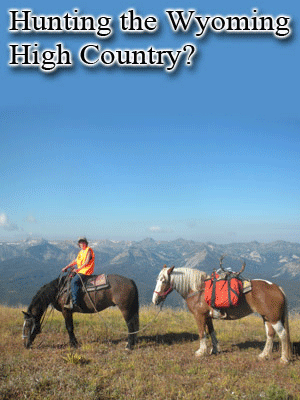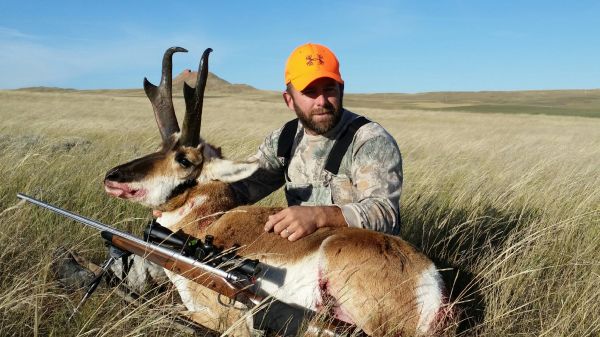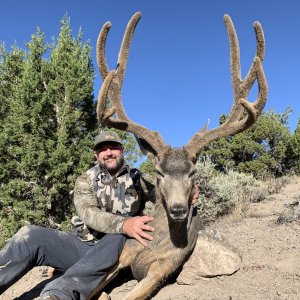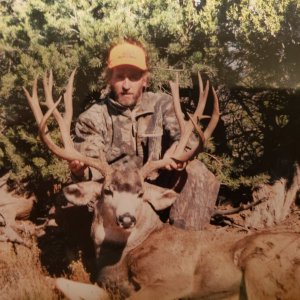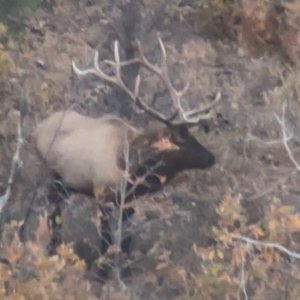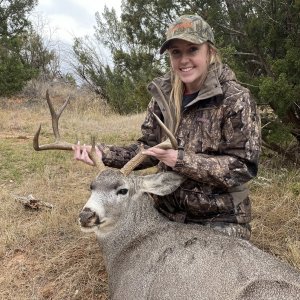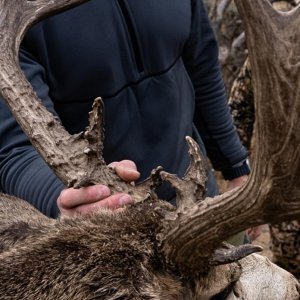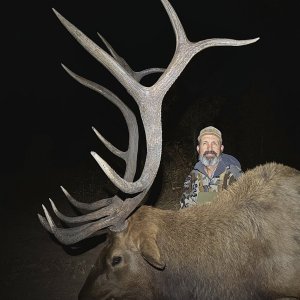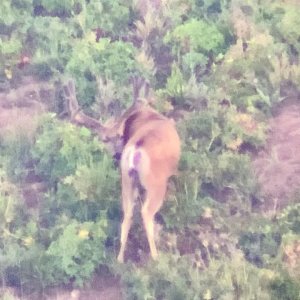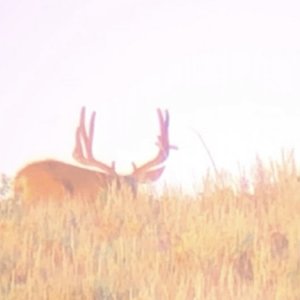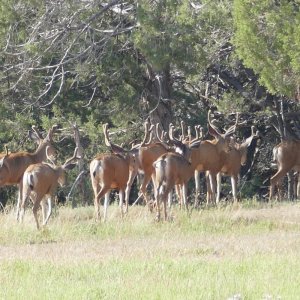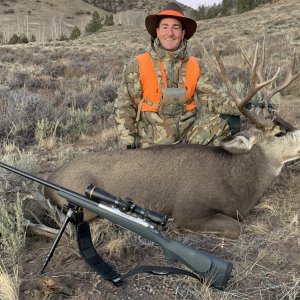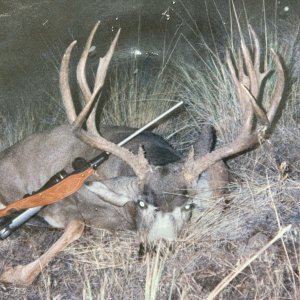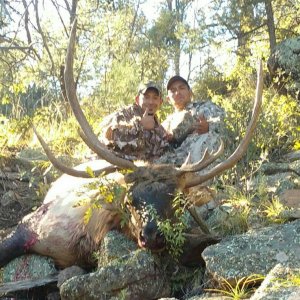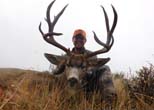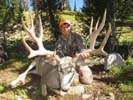You are using an out of date browser. It may not display this or other websites correctly.
You should upgrade or use an alternative browser.
You should upgrade or use an alternative browser.
Field judging antelope
- Thread starter Riley7/08
- Start date
midwesthunter
Member
- Messages
- 96
prong length, mass, and the higher the prong is from the base the better
nontypical
Long Time Member
- Messages
- 4,198
1: Mass, mass, and mass. The lower the prong, the better the mass measurements below the prong.
2. Length of prong. The better the mass, the longer the prong.
3. Horn length comes in last, especially in Wyoming. Our goats don't get the length that Arizona and New Mexico do in general.
Prongs that come out lower on the horn can mean much bigger mass measurements due to the rule that at least 2 mass measurements must come from below the prong. Very rare to get three mass measurements on a pronghorn below the prong. If the beginning of the prong is in the 3rd mass measurement, you must make that measurement ABOVE the prong.
2. Length of prong. The better the mass, the longer the prong.
3. Horn length comes in last, especially in Wyoming. Our goats don't get the length that Arizona and New Mexico do in general.
Prongs that come out lower on the horn can mean much bigger mass measurements due to the rule that at least 2 mass measurements must come from below the prong. Very rare to get three mass measurements on a pronghorn below the prong. If the beginning of the prong is in the 3rd mass measurement, you must make that measurement ABOVE the prong.
grosventrehunter
Very Active Member
- Messages
- 1,805
+1 on mass,mass,and mass.
To be honest...In the field, I first look to see if the prongs start at or above the ears. They will have to for the buck to be over 14" (unless some very rare creature), which is a reasonable starting point no matter the unit. This let's me quickly dismiss a a lot of bucks, allowing me more time tokeep looking.
Second, I do look for length, although I concede that mass is more important for total score, longer horns are cool on antelope. Your figure of 6" for the ear is good, but you might miss some big boys early in the season.
My best buck I wouldn't have shot early, by the 6" rule (or 8 eye to nose) he looked like a 14" buck. But it was later in the season, and he was with several other bucks, and he was at least a third larger in body than the others. When he stood next to one who's ears indicated a 14" buck (he did too), I dropped the hammer. He was 16" long and 84 2/8; but looked like a 14" 76-77 buck. I would have passed him if it was September and he was the only buck chasing a herd of does.
Second, I do look for length, although I concede that mass is more important for total score, longer horns are cool on antelope. Your figure of 6" for the ear is good, but you might miss some big boys early in the season.
My best buck I wouldn't have shot early, by the 6" rule (or 8 eye to nose) he looked like a 14" buck. But it was later in the season, and he was with several other bucks, and he was at least a third larger in body than the others. When he stood next to one who's ears indicated a 14" buck (he did too), I dropped the hammer. He was 16" long and 84 2/8; but looked like a 14" 76-77 buck. I would have passed him if it was September and he was the only buck chasing a herd of does.
Riley7/08
Active Member
- Messages
- 166
>To be honest...In the field, I
>first look to see if
>the prongs start at or
>above the ears. They
>will have to for the
>buck to be over 14"
>(unless some very rare creature),
>which is a reasonable starting
>point no matter the unit.
>This let's me quickly dismiss
>a a lot of bucks,
>allowing me more time tokeep
>looking.
>
>Second, I do look for length,
>although I concede that mass
>is more important for total
>score, longer horns are cool
>on antelope. Your figure
>of 6" for the ear
>is good, but you might
>miss some big boys early
>in the season.
>
>My best buck I wouldn't have
>shot early, by the 6"
>rule (or 8 eye to
>nose) he looked like a
>14" buck. But it
>was later in the season,
>and he was with several
>other bucks, and he was
>at least a third larger
>in body than the others.
> When he stood next
>to one who's ears indicated
>a 14" buck (he did
>too), I dropped the hammer.
> He was 16" long
>and 84 2/8; but looked
>like a 14" 76-77 buck.
> I would have passed
>him if it was September
>and he was the only
>buck chasing a herd of
>does.
Good info there, I like to hear how other guys judge them in the field. looking for a trick I may have missed
>first look to see if
>the prongs start at or
>above the ears. They
>will have to for the
>buck to be over 14"
>(unless some very rare creature),
>which is a reasonable starting
>point no matter the unit.
>This let's me quickly dismiss
>a a lot of bucks,
>allowing me more time tokeep
>looking.
>
>Second, I do look for length,
>although I concede that mass
>is more important for total
>score, longer horns are cool
>on antelope. Your figure
>of 6" for the ear
>is good, but you might
>miss some big boys early
>in the season.
>
>My best buck I wouldn't have
>shot early, by the 6"
>rule (or 8 eye to
>nose) he looked like a
>14" buck. But it
>was later in the season,
>and he was with several
>other bucks, and he was
>at least a third larger
>in body than the others.
> When he stood next
>to one who's ears indicated
>a 14" buck (he did
>too), I dropped the hammer.
> He was 16" long
>and 84 2/8; but looked
>like a 14" 76-77 buck.
> I would have passed
>him if it was September
>and he was the only
>buck chasing a herd of
>does.
Good info there, I like to hear how other guys judge them in the field. looking for a trick I may have missed
jm77
Long Time Member
- Messages
- 3,345
>First thing I will say is
>listen to Non typical on
>all things that is antelope...
> He knows his stuff!
>
>
>Second I will pass along how
>my uncle told me to
>judge them when I was
>a youngster. "It is like
>a rattlesnake, you will know
>it when you see it!"
>
^^^+1 on nontypical
>listen to Non typical on
>all things that is antelope...
> He knows his stuff!
>
>
>Second I will pass along how
>my uncle told me to
>judge them when I was
>a youngster. "It is like
>a rattlesnake, you will know
>it when you see it!"
>
^^^+1 on nontypical
Zeke
Long Time Member
- Messages
- 10,603
>>First thing I will say is
>>listen to Non typical on
>>all things that is antelope...
>> He knows his stuff!
>>
>>
>>Second I will pass along how
>>my uncle told me to
>>judge them when I was
>>a youngster. "It is like
>>a rattlesnake, you will know
>>it when you see it!"
>>
>
>^^^+1 on nontypical
+2 on nontypical.
Zeke
>>listen to Non typical on
>>all things that is antelope...
>> He knows his stuff!
>>
>>
>>Second I will pass along how
>>my uncle told me to
>>judge them when I was
>>a youngster. "It is like
>>a rattlesnake, you will know
>>it when you see it!"
>>
>
>^^^+1 on nontypical
+2 on nontypical.
Zeke
deerfanatic
Active Member
- Messages
- 122
LAST EDITED ON Jul-21-17 AT 06:42AM (MST)[p]LAST EDITED ON Jul-20-17 AT 10:12?PM (MST)
Nontypical is spot on. In my opinion though, TKnez's uncle has the best advice with goats..."you'll know it when you see it". Goats are so hard to judge because of several factors.
1). The capes on an antelope vary drastically. Really dark faced goats will tend to look bigger compared to ones that are more tan.
2) Depending on where you hunt, you may look at 40, 50, 100 or more bucks in a day. Some close and some far. After looking at 100 bucks, your head starts to play games with you. Factor in the average sized buck running around in your area...if the standard buck in your area is a 60" antelope, that 70" buck that your spotting scope finds is going to be looking pretty good after seeing 100 bucks in the 160 class range. Our brains are wired to see patterns, so that odd ball is going to naturally be compared to the standard.
3) Add distance to the equation with a spotting scope. If you are sizing things up on average say 1500 yards away and then size one up at 300, he is going to appear bigger to you. Again it has to do you how we are wired to perceive things.
4) Several posts gave great advice about ear length, mass, prong positioning, height, etc. All great advice. After seeing all those bucks, you start focusing on the part you really like. "My what mass he has, or that one is really tall, or that one has a prong up super high. You have to keep your whits and look at the total package.
This leads back to the advice of "you will know it when you see it". All I can say is I have only shot two antelope that haven't had ground shrinkage after I walked up to them. The two bucks that didn't, I knew it when I saw them. Didn't even have to go through all the...his prong in here, his length is this compared to his ears, his mass is this, etc. when you see him, he has it all.
Nontypical is spot on. In my opinion though, TKnez's uncle has the best advice with goats..."you'll know it when you see it". Goats are so hard to judge because of several factors.
1). The capes on an antelope vary drastically. Really dark faced goats will tend to look bigger compared to ones that are more tan.
2) Depending on where you hunt, you may look at 40, 50, 100 or more bucks in a day. Some close and some far. After looking at 100 bucks, your head starts to play games with you. Factor in the average sized buck running around in your area...if the standard buck in your area is a 60" antelope, that 70" buck that your spotting scope finds is going to be looking pretty good after seeing 100 bucks in the 160 class range. Our brains are wired to see patterns, so that odd ball is going to naturally be compared to the standard.
3) Add distance to the equation with a spotting scope. If you are sizing things up on average say 1500 yards away and then size one up at 300, he is going to appear bigger to you. Again it has to do you how we are wired to perceive things.
4) Several posts gave great advice about ear length, mass, prong positioning, height, etc. All great advice. After seeing all those bucks, you start focusing on the part you really like. "My what mass he has, or that one is really tall, or that one has a prong up super high. You have to keep your whits and look at the total package.
This leads back to the advice of "you will know it when you see it". All I can say is I have only shot two antelope that haven't had ground shrinkage after I walked up to them. The two bucks that didn't, I knew it when I saw them. Didn't even have to go through all the...his prong in here, his length is this compared to his ears, his mass is this, etc. when you see him, he has it all.
deerfanatic
Active Member
- Messages
- 122
Nice catch guys? A guy really shouldn't be posting stuff when he's been up to long. I would love to find that spot too.
DoubleDropMuley
Very Active Member
- Messages
- 1,814
I agree with fellow MMer's Mass and you will Know when ya see an exceptional buck. They are hard to judge but when ya see mid 80's youll know to shoot. Now 160" now that's a no brainer lol. But im with Deerfanatic, it's not being up to long its just the thought of muleys take over even when trying to discuss antelope, elk or any other Species!!
DoubleDropMuley
Very Active Member
- Messages
- 1,814
Just a guess but id say 75-77"?
deerfanatic
Active Member
- Messages
- 122
LAST EDITED ON Jul-21-17 AT 07:38PM (MST)[p]I will play...170 ? ?
72 5/8" would be my guess.
Going back to the original question, several posted about prong coming in high above the ears. I would have originally stated the same, but I believe nontypical is correct about a big massive prong down low simply from the measurements rules.
The othe piece that can really help or hurt a score is the way the horn curls. If I'm not mistaken the length is measured middle of horn on the outside edge up and around. A big curl to the middle can make a seamingly short buck have good length. Many antelope will curve towards their rear end or forward to their nose. That geometry actually hurts the length quite a bit because of the measurement rules. Now I'm no expert so maybe someone in the know can confirm.
72 5/8" would be my guess.
Going back to the original question, several posted about prong coming in high above the ears. I would have originally stated the same, but I believe nontypical is correct about a big massive prong down low simply from the measurements rules.
The othe piece that can really help or hurt a score is the way the horn curls. If I'm not mistaken the length is measured middle of horn on the outside edge up and around. A big curl to the middle can make a seamingly short buck have good length. Many antelope will curve towards their rear end or forward to their nose. That geometry actually hurts the length quite a bit because of the measurement rules. Now I'm no expert so maybe someone in the know can confirm.
GroundScrounger
Member
- Messages
- 32
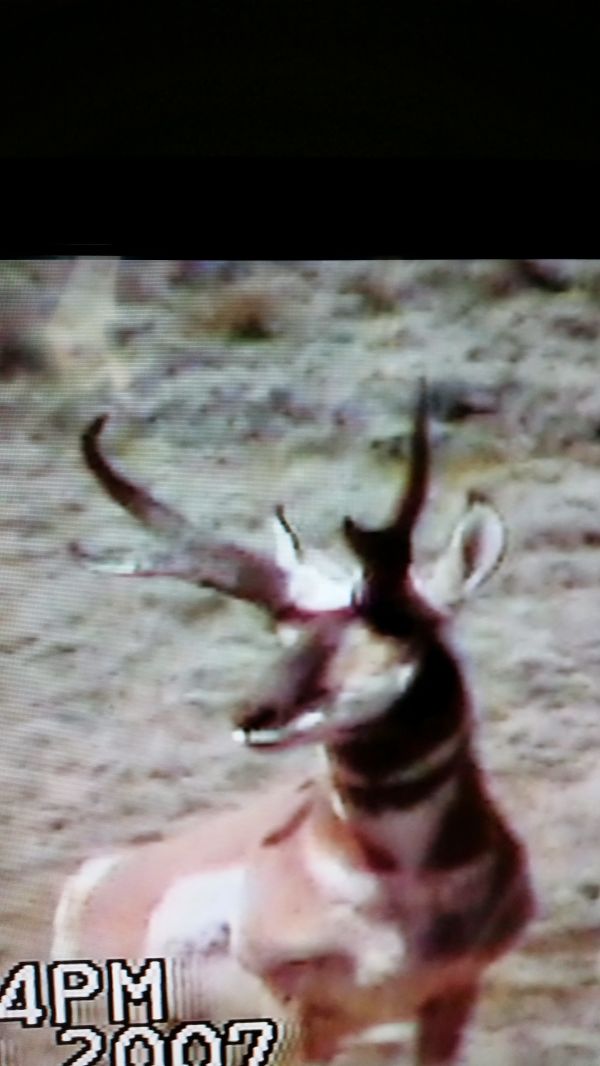
Watched this guy for three years. Biggest goat I've ever seen. I never got lucky in the draw so he probably died of old age. Thought it was a little weird but He liked to stay in the buck brush and I would jump him while deer hunting every year. To me he had that "rattle snake" look to him. Never seen one with prongs like that before, looked more like forks. The guys are right, you'll know when you see the big boy.
runamuk
Very Active Member
- Messages
- 1,502
I drew a pretty decent tag in Idaho and have been doing a little research on field judging Antelope also, I had this same tag about 10 /12 years ago and screwed up bad, shooting a dink thinking he was a good buck , sure don't want that to happen again!
Tags are just to far n few between.
Here's a pretty good read on the subject,
Pretty much what nontypical advises.
http://www.boone-crockett.org/bgRecords/records_fieldjudging_pronghorn.asp?area=bgRecords
Tags are just to far n few between.
Here's a pretty good read on the subject,
Pretty much what nontypical advises.
http://www.boone-crockett.org/bgRecords/records_fieldjudging_pronghorn.asp?area=bgRecords
SPAZ
Active Member
- Messages
- 568
Mass. If they don't have it - keep looking. Pronghorn are so easily over judged if they don't have mass, and usually under judged if they do. If they look heavy, stop and start looking more seriously. Keep in mind if they are very heavy - it sometimes will give the illusion they are shorter than they are, and it can make their prongs look short as well since the prong measurement starts at the back center of the horn. The hook or the arc of the horns, as well as how they flare (prongs and angle of horns), as well as the circular/oval shape along the length of the horn, all come into play on how to judge the mass/length/prong. You gotta look at them from every angle. Body/head/ear size can be used but can vary greatly. The eyeball size is very consistent and should be used when judging mass. Sometimes a tiny bodied/head/ear antelope can look huge. Sometimes a huge bodied goat with a giant head can look unimpressive, even with a mid-80s kind of head.
Look at a ton of them. Get close and take pictures. Look at each goat from every angle. Use the eyeball to judge mass. Don't rush a decision on shooting. And for God's sake, don't listen to TopGun.
Look at a ton of them. Get close and take pictures. Look at each goat from every angle. Use the eyeball to judge mass. Don't rush a decision on shooting. And for God's sake, don't listen to TopGun.
"And for God's
sake, don't listen to TopGun.
Yea; don't listen to a guy that's been on five hunts the last five years with goats being taken that scored between 77" and an official B&C all time record book 84 4/8"! Nope, don't know a thing about what a good goat looks like, LOL!
sake, don't listen to TopGun.
Yea; don't listen to a guy that's been on five hunts the last five years with goats being taken that scored between 77" and an official B&C all time record book 84 4/8"! Nope, don't know a thing about what a good goat looks like, LOL!
BuzzH
Long Time Member
- Messages
- 6,057
LAST EDITED ON Jul-24-17 AT 08:59PM (MST)[p]I agree with SPAZ to look at the mass on bucks and pay attention to body size, they vary a lot even within a given hunting unit.
If you're really looking for a buck over 80, they just don't get there without great mass both above and below the prongs. If they lack mass...they need a lot of help with length and/or prong.
It also takes sorting through a bunch to find one that has it all...very rewarding when you find one though.
I also don't agree that you'll always "know a big one when you see it"...I about didn't shoot my best buck and that would have been a huge mistake. Had a big head, big body, and also big horns. On the hoof, it didn't look as big as it was.
If you're really looking for a buck over 80, they just don't get there without great mass both above and below the prongs. If they lack mass...they need a lot of help with length and/or prong.
It also takes sorting through a bunch to find one that has it all...very rewarding when you find one though.
I also don't agree that you'll always "know a big one when you see it"...I about didn't shoot my best buck and that would have been a huge mistake. Had a big head, big body, and also big horns. On the hoof, it didn't look as big as it was.
>LAST EDITED ON Jul-24-17
>AT 08:59?PM (MST)
>
>I agree with SPAZ to look
>at the mass on bucks
>and pay attention to body
>size, they vary a lot
>even within a given hunting
>unit.
>
>If you're really looking for a
>buck over 80, they just
>don't get there without great
>mass both above and below
>the prongs. If they lack
>mass...they need a lot of
>help with length and/or prong.
>
>
>It also takes sorting through a
>bunch to find one that
>has it all...very rewarding when
>you find one though.
>
>I also don't agree that you'll
>always "know a big one
>when you see it"...I about
>didn't shoot my best buck
>and that would have been
>a huge mistake. Had a
>big head, big body, and
>also big horns. On the
>hoof, it didn't look as
>big as it was.
He's alive!
>AT 08:59?PM (MST)
>
>I agree with SPAZ to look
>at the mass on bucks
>and pay attention to body
>size, they vary a lot
>even within a given hunting
>unit.
>
>If you're really looking for a
>buck over 80, they just
>don't get there without great
>mass both above and below
>the prongs. If they lack
>mass...they need a lot of
>help with length and/or prong.
>
>
>It also takes sorting through a
>bunch to find one that
>has it all...very rewarding when
>you find one though.
>
>I also don't agree that you'll
>always "know a big one
>when you see it"...I about
>didn't shoot my best buck
>and that would have been
>a huge mistake. Had a
>big head, big body, and
>also big horns. On the
>hoof, it didn't look as
>big as it was.
He's alive!
nontypical
Long Time Member
- Messages
- 4,198
+1, SPAZ. Great advice.
Similar threads
- Replies
- 15
- Views
- 1k
- Replies
- 0
- Views
- 527
Wyoming Hunting Guides & Outfitters
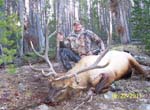 Urge 2 Hunt
Urge 2 Hunt
We focus on trophy elk, mule deer, antelope and moose hunts and take B&C bucks most years.
